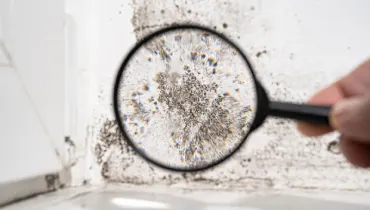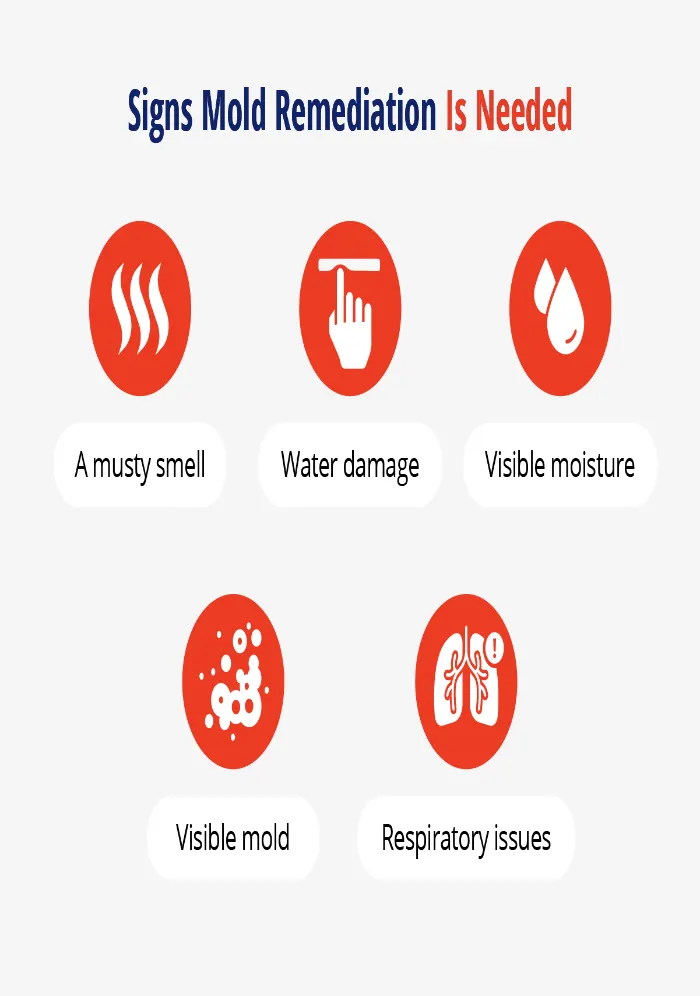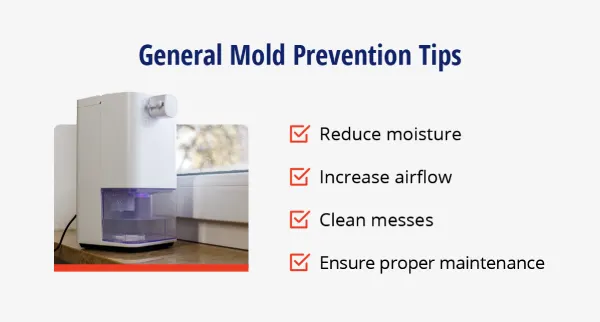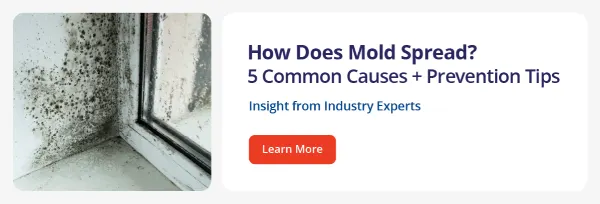
Mold remediation is essential for maintaining a safe and healthy environment. According to Rainbow Restoration, remediation is required in the following situations:
|
|
Mold remediation is required whenever mold is discovered on a property. Professionals can properly remove mold without the risk of spreading it, causing additional damage, or impacting the health of occupants. |
Discovering mold can be alarming, and it's important to address the issue promptly. Mold remediation is the process of removing mold and addressing the underlying moisture issues that caused it. So, when is mold remediation required?
Any type of mold growth should be addressed by remediation professionals as it poses potential health risks and structural damage. Learn what mold remediation is, when it’s required, and tips for preventing future mold growth.
Table of Contents
- What Is Mold Remediation?
- Signs Mold Remediation Is Needed
- Why It’s Important To Call a Professional
- The Mold Remediation Process
- Mold Prevention Tips
- Call the Mold Remediation Professionals at Rainbow Restoration®
- FAQ About Mold Remediation
What Is Mold Remediation?
Mold remediation is the process of removing mold and addressing the underlying moisture issues that caused it. Mold remediation or mold abatement professionals will remove and dispose of any contaminated porous materials. Non- or semi-porous materials may be cleaned and restored. The cause of the mold will then be addressed, such as leaks or poor air circulation.

5 Signs Mold Remediation Is Needed
Signs of mold in a house or commercial property should be addressed immediately by professionals. Mold can cause serious health problems, including respiratory issues, allergies, and, in severe cases, more serious illnesses. It can also damage the structure of a building. It's crucial to address mold issues promptly, and knowing what to look out for is the first step.
- A musty smell with no clear cause: A stale or musty smell can indicate mold growth. If there are no visible signs of mold, it means the mold may be growing within the property's walls or foundation.
- Signs of water damage: If there are signs of water damage like discoloration, peeling paint, or soft spots in the wall or ceiling, it's important to investigate further, as it could indicate a hidden mold problem, particularly if there’s been a recent damaging storm or other event.
- Visible moisture: Visible moisture, such as water stains, condensation, or dampness on surfaces, provides the ideal conditions for mold growth. This creates a humid environment where mold spores can thrive and multiply, leading to potential health hazards and structural damage.
- Visible mold: Mold can appear in various colors, including black, white, green, or gray. It often looks like fuzzy or fluffy patches and can be found in various textures, from slimy to powdery. Mold can grow on organic materials such as drywall, paper, and wood.
- Sinus or other health issues: Mold exposure can lead to respiratory problems like coughing, sneezing, and difficulty breathing. People may also experience eye irritation, skin rashes, headaches, and fatigue. In severe cases, mold exposure can trigger more serious health issues, especially for individuals with allergies or existing respiratory conditions.
Why It’s Important To Call a Professional
While small, isolated patches of mold might seem manageable for a DIY project, the extent of the mold issue is not always clear from what is visible. Larger infestations or mold in hidden areas can pose significant health and structural damage risks. Attempting to remove mold without proper training and equipment can lead to accidental spore dispersal, worsening the problem and exposing occupants to harmful toxins.
The Mold Remediation Process
Removal and remediation should be handled promptly by professionals who understand mold facts and proper procedures to prevent further spread and potential health risks. A timely and expert approach ensures effective removal and addresses the underlying causes. This process typically involves several steps, including:
- Assessment: An Indoor Environmental Professional (IEP) will assess the extent of the mold damage and identify the source of moisture.
- Containment: The affected area is isolated to prevent the spread of mold spores.
- Removal: Moldy materials, such as drywall or insulation, are removed and disposed of properly.
- Cleaning: Remaining surfaces are cleaned with specialized cleaning agents to kill mold and remove spores.
- Drying: The area is thoroughly dried to reduce moisture levels and prevent future mold growth.
- Repair: Any damaged materials are repaired or replaced.
- Prevention: Measures are taken to address the underlying moisture issue, such as fixing water damage or improving ventilation.

Mold Prevention Tips
Mold grows where moisture is present. To prevent mold growth, it's essential to maintain a dry, well-ventilated space. Regularly inspect the property for signs of water damage, such as leaks, condensation, or high humidity levels. Promptly address any issues to prevent mold from taking root.
Some general tips to prevent mold growth include:
- Reducing moisture: Fix leaky pipes and faucets promptly. Control humidity by using dehumidifiers in damp areas. The relative humidity should be no more than 50%.
- Increasing airflow: Ensure proper ventilation in bathrooms, kitchens, and other moisture-prone areas. Use exhaust fans during showers and cooking.
- Cleaning incursions or other water right away: Clean up spills and water damage immediately. Contact the professionals at Rainbow Restoration for help with water damage.
- Ensuring proper maintenance: Properly maintain the HVAC system to ensure proper airflow and dehumidification.
By following these simple preventive measures, the risk of mold growth can be significantly reduced. A proactive approach to moisture control and ventilation will create an environment that is inhospitable to mold, safeguarding occupants’ health and property.
Call the Mold Remediation Professionals at Rainbow Restoration
Mold remediation is recommended as soon as mold is suspected or confirmed. Professionals will clean up the mold and address the underlying causes, restoring items where possible. The team at Rainbow Restoration has decades of experience with mold remediation and knows how important it is to restore a property as quickly as possible.
Contact your local Rainbow Restoration for mold removal and remediation services today.
This article is intended for general informational purposes only and may not be applicable to every situation. You are responsible for determining the proper course of action for your home and property. Rainbow Restoration is not responsible for any damages that occur as a result of this blog content or your actions. For the most accurate guidance, contact the Rainbow Restoration location nearest you for a comprehensive, on-site assessment.
FAQ About Mold Remediation
Setting the highest standards in water, fire, and mold damage restoration requires a continuous focus and dedication to education and improvement. This commitment to exceptional service also includes using our years of experience and expertise to answer your restoration questions.
Here are answers to some of the most frequently asked questions about mold remediation.
How much mold is too much?
Any amount of mold is too much, but the more mold present, the greater the potential health risks. If there is any visible mold, it's crucial to address the issue promptly, especially if it's extensive or in areas with high moisture levels.
Does mold remediation work?
Yes, mold remediation works when performed by professionals. Addressing the underlying moisture issues and removing moldy materials can significantly reduce or eliminate mold problems and improve indoor air quality.
Do you have to get rid of everything if your house has mold?
Any porous materials, such as carpeting or bedding, must be removed and disposed of. Semi- or non-porous materials may be cleaned. Remediation professionals can help determine what needs to be cleaned and removed.
What is the protocol for mold remediation?
Mold remediation involves a multi-step process. First, an Indoor Environmental Professional (IEP) will write the protocol for the property in question. Then, restoration professionals will follow the IEP protocol to remediate the mold. Finally, the IEP will take air samples to confirm the mold has been successfully remediated.

